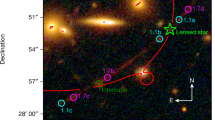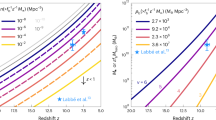Abstract
The observed number counts of high-redshift galaxy candidates1,2,3,4,5,6,7,8 have been used to build up a statistical description of star-forming activity at redshift z ≳ 7, when galaxies reionized the Universe1,2,9,10. Standard models11 predict that a high incidence of gravitational lensing will probably distort measurements of flux and number of these earliest galaxies. The raw probability of this happening has been estimated to be ∼0.5 per cent (refs 11, 12), but can be larger owing to observational biases. Here we report that gravitational lensing is likely to dominate the observed properties of galaxies with redshifts of z ≳ 12, when the instrumental limiting magnitude is expected to be brighter than the characteristic magnitude of the galaxy sample. The number counts could be modified by an order of magnitude, with most galaxies being part of multiply imaged systems, located less than 1 arcsec from brighter foreground galaxies at z ≈ 2. This lens-induced association of high-redshift and foreground galaxies has perhaps already been observed among a sample of galaxy candidates identified at z ≈ 10.6. Future surveys will need to be designed to account for a significant gravitational lensing bias in high-redshift galaxy samples.
This is a preview of subscription content, access via your institution
Access options
Subscribe to this journal
Receive 51 print issues and online access
$199.00 per year
only $3.90 per issue
Buy this article
- Purchase on Springer Link
- Instant access to full article PDF
Prices may be subject to local taxes which are calculated during checkout



Similar content being viewed by others
References
Bouwens, R. J. et al. UV luminosity functions from 113 z ∼ 7 and z ∼ 8 Lyman-break galaxies in the ultra-deep HUDF09 and wide-area ERS WFC3/IR observations. Preprint at 〈http://arxiv.org/abs/1006.4360〉 (2010)
Lorenzoni, S. et al. Candidate z ∼ 8 – 9 galaxies from WFC3 imaging. Preprint at 〈http://arxiv.org/abs/1006.3545〉 (2010)
Bouwens, R. J. et al. Constraints on the first galaxies: z ∼ 10 galaxy candidates from HST WFC3/IR. Preprint at 〈http://arxiv.org/abs/0912.4263〉 (2009)
Yan, H. et al. Galaxy formation in the reionization epoch as hinted by Wide Field Camera 3 observations of the Hubble Ultra Deep Field. Res. Astron. Astrophys. 10, 867–904 (2010)
Bouwens, R. J. et al. Star formation at z ∼ 6: the Hubble Ultra Deep Parallel Fields. Astrophys. J. 606, L25–L28 (2004)
Yan, H. & Windhorst, R. A. Candidates of z ∼ 5.5 – 7 galaxies in the Hubble Space Telescope Ultra Deep Field. Astrophys. J. 612, L93–L96 (2004)
Wilkins, S. M. et al. Probing L * Lyman-break galaxies at z ∼ 7 in GOODS-South with WFC3 on Hubble Space Telescope. Mon. Not. R. Astron. Soc. 403, 938–944 (2010)
McLure, R. J. et al. Galaxies at z = 6 – 9 from the WFC3/IR imaging of the Hubble Ultra Deep Field. Mon. Not. R. Astron. Soc. 403, 960–983 (2010)
Yan, H. & Windhorst, R. A. The major sources of the cosmic reionizing background at z ∼ 6. Astrophys. J. 600, L1–L5 (2004)
Trenti, M. et al. The galaxy luminosity function during the reionization epoch. Astrophys. J. 714, L202–L207 (2010)
Barkana, R. & Loeb, A. High-redshift galaxies: their predicted size and surface brightness distributions and their gravitational lensing probability. Astrophys. J. 531, 613–623 (2000)
Comerford, J. M., Haiman, Z. & Schaye, J. Constraining the redshift z ∼ 6 quasar luminosity function using gravitational lensing. Astrophys. J. 580, 63–72 (2002)
Turner, E. L., Ostriker, J. P. & Gott, J. R., III The statistics of gravitational lenses — the distributions of image angular separations and lens redshifts. Astrophys. J. 284, 1–22 (1984)
Richard, J. et al. A Hubble and Spitzer Space Telescope survey for gravitationally lensed galaxies: further evidence for a significant population of low-luminosity galaxies beyond z = 7. Astrophys. J. 685, 705–724 (2008)
Bradley, L. D. et al. Discovery of a very bright strongly lensed galaxy candidate at z ∼ 7.6. Astrophys. J. 678, 647–654 (2008)
Zheng, W. et al. Bright strongly lensed galaxies at redshift z ∼ 6 – 7 behind the clusters Abell 1703 and CL0024+16. Astrophys. J. 697, 1907–1917 (2009)
Bouwens, R. J. et al. z ∼ 7 – 10 galaxies behind lensing clusters: contrast with field search results. Astrophys. J. 690, 1764–1771 (2009)
Webster, R. L., Hewett, P. C., Harding, M. E. & Wegner, G. A. Detection of statistical gravitational lensing by foreground mass distributions. Nature 336, 358–359 (1988)
Nollenberg, J. G. & Williams, L. L. R. Galaxy-quasar correlations between APM galaxies and Hamburg-ESO QSOs. Astrophys. J. 634, 793–805 (2005)
Scranton, R. et al. Detection of cosmic magnification with the Sloan Digital Sky Survey. Astrophys. J. 633, 589–602 (2005)
Windhorst, R. A., Cohen, S. H., Jansen, R. A., Conselice, C. & Yan, H. How JWST can measure first light, reionization and galaxy assembly. N. Astron. Rev. 50, 113–120 (2006)
Schechter, P. An analytic expression for the luminosity function for galaxies. Astrophys. J. 203, 297–306 (1976)
Pei, Y. C. Magnification of quasars by cosmologically distributed gravitational lenses. Astrophys. J. 440, 485–500 (1995)
Greif, T. H., Johnson, J. L., Bromm, V. & Klessen, R. S. The first supernova explosions: energetics, feedback, and chemical enrichment. Astrophys. J. 670, 1–14 (2007)
Hathi, N. P. et al. UV-dropout galaxies in the GOODS-South Field from WFC3 early release science observations. Astrophys. J. 720, 1708–1716 (2010)
Oguri, M. et al. The Sloan Digital Sky Survey quasar lens search. III. Constraints on dark energy from the third data release quasar lens catalog. Astron. J. 135, 512–519 (2008)
Choi, Y., Park, C. & Vogeley, M. S. Internal and collective properties of galaxies in the Sloan Digital Sky Survey. Astrophys. J. 658, 884–897 (2007)
Huterer, D., Keeton, C. R. & Ma, C. Effects of ellipticity and shear on gravitational lens statistics. Astrophys. J. 624, 34–45 (2005)
Komatsu, E. et al. Five-year Wilkinson Microwave Anisotropy Probe observations: cosmological interpretation. Astrophys. J. Suppl. 180330–376 (2009)
Windhorst, R. A. et al. High resolution science with high redshift galaxies. Adv. Space Res. 41, 1965–1971 (2008)
Acknowledgements
We thank K.-H. Chae for discussing results of his lensing calculations. J.S.B.W. was supported in part by a QE-II fellowship and grants from the Australian Research Council. H.Y. acknowledges support from the long-term fellow-ship programme of the Center for Cosmology and AstroParticle Physics (CCAPP) at The Ohio State University. H.Y. and R.A.W. were supported by the Space Telescope Science Institute, which is operated by the Association of Universities for Research in Astronomy, Inc. R.A.W. was supported by a NASA JWST Interdisciplinary Scientist grant.
Author information
Authors and Affiliations
Contributions
J.S.B.W. performed the calculations of lensing probabilities. H.Y. measured the distributions of galaxy properties from the HUDF. All authors were involved in the conception of the work, discussing the results, and writing the manuscript.
Corresponding author
Ethics declarations
Competing interests
The authors declare no competing financial interests.
Supplementary information
Supplementary Information
The file contains Supplementary Text, Supplementary References and Supplementary Figures 1-5 with legends. (PDF 621 kb)
Rights and permissions
About this article
Cite this article
Wyithe, J., Yan, H., Windhorst, R. et al. A distortion of very-high-redshift galaxy number counts by gravitational lensing. Nature 469, 181–184 (2011). https://doi.org/10.1038/nature09619
Received:
Accepted:
Published:
Issue Date:
DOI: https://doi.org/10.1038/nature09619
This article is cited by
-
The future of astronomy with small satellites
Nature Astronomy (2020)
-
The numerical frontier of the high-redshift Universe
Computational Astrophysics and Cosmology (2015)
Comments
By submitting a comment you agree to abide by our Terms and Community Guidelines. If you find something abusive or that does not comply with our terms or guidelines please flag it as inappropriate.



